|
|
|
Sort Order |
|
|
|
Items / Page
|
|
|
|
|
|
|
| Srl | Item |
| 1 |
ID:
167282


|
|
|
|
|
| Summary/Abstract |
Can a leader reduce the audience costs imposed for backing down completely on a threat by opting instead to ‘back up’ to a less hawkish policy? Current research examines the political repercussions of making a threat and then taking no action at all. Real world leaders, however, often ‘back up’ and implement policies that involve some action – for instance, imposing sanctions after threatening military force, rather than backing down entirely. This article argues that audience costs can be mitigated through policy substitution: backing up to less hawkish policies – that reduce inconsistency between a leader’s words and deeds – may reduce audience costs. A series of original survey experiments finds support for the argument and demonstrates that the population treats inconsistency as a continuum. The findings have implications for domestic politics and crisis bargaining. Domestically, a leader who backs up faces lower audience costs and is seen as more competent than one who backs down. Yet those on the receiving end of threats are less likely to believe the future threats of a foreign leader who has previously backed up or backed down. Backing up therefore degrades the credibility of crisis signals by making it difficult for rivals to distinguish between credible threats and those that will be backed up.
|
|
|
|
|
|
|
|
|
|
|
|
|
|
|
|
| 2 |
ID:
167276
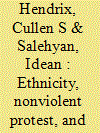

|
|
|
|
|
| Summary/Abstract |
Why do governments use deadly force against unarmed protesters? The government’s threat perception may be a function of the mobilization potential of the opposition and/or the size of the ruling elite’s support coalition. Given the high salience of ethnicity in African politics, governments that depend on small ethnic coalitions will see peaceful protests as more threatening, as the opposition may be able to draw on larger numbers of potential dissidents and excluded groups. Alternately, governments with larger, more homogeneous ethnic coalitions will find nonviolent mobilization less threatening and will be less likely to respond with deadly force. Using the Social Conflict Analysis Database, we demonstrate that as the size – and to a lesser extent homogeneity – of the ethnic ruling coalition grows, governments are significantly less likely to use deadly force against nonviolent protesters. This finding is robust to several operationalizations of the size of the government’s support coalition, the inclusion of other measures of ethnic demographics, and estimators that account for the hierarchical nature of the data. Threat perception hinges not only on dissident tactics but on their demands, their mobilization potential, and their capacity to impose costs on the government. This article demonstrates that the size and composition of the government’s ethnic support base matters as well.
|
|
|
|
|
|
|
|
|
|
|
|
|
|
|
|
| 3 |
ID:
167281
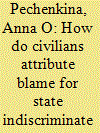

|
|
|
|
|
| Summary/Abstract |
State indiscriminate violence against civilians has been viewed as counterproductive for the government. This conclusion hinges on the assumption that indiscriminate violence aggrieves civilians against the government even when the rebels provoke the state by using civilians as human shields. An alternative view suggests that civilians recognize if the rebels exploit them as human shields and blame the rebels if such provocation occurs. We ask: do civilians evaluate all state indiscriminate violence in the same way or do they think of state indiscriminate violence differently when it is provoked by insurgents? Accounting for the covariate differences between individuals with and without personal experience of warfare in the survey data from postwar Ukraine, we find that personal exposure to violence shapes one’s blame attribution for provoked state attacks on civilians. Individuals unexposed to violence tend to take into account whether the government was provoked by the rebels. By contrast, individuals with personal experience of warfare tend to blame the government for indiscriminate attacks regardless of rebel provocation. This finding has implications for counterinsurgency scholarship and policy. It is likely that the difference between unexposed and exposed to violence civilians emerges in geographically isolated conflicts. If so, targeting of civilians may have different effects on the escalation of insurgency in geographically concentrated as opposed to widespread cases of violence.
|
|
|
|
|
|
|
|
|
|
|
|
|
|
|
|
| 4 |
ID:
167280
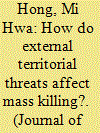

|
|
|
|
|
| Summary/Abstract |
The current scholarship on mass killing demonstrates that genocide and other forms of mass murder are usually policy responses to threats, emphasizing armed conflict and political upheaval, such as revolution, as important causal factors. However, scholars have so far had little to say about the relationship between a country’s external threat environment and mass killing. We argue that a country’s external security environment, particularly when its neighbors pose threats to its territorial integrity, is a critical and understudied factor shaping a leader’s decision to employ mass killing. External territorial threats can produce domestic in-group/out-group dynamics, heightening fears that some domestic groups may be supporting or colluding with the enemy. Yet, given the availability of alternative policies and the enormous costs of mass killing, territorial threats alone do not suffice to explain why a state chooses mass killing over other types of violent or nonviolent strategies. Only when leaders are committed to exclusionary ideologies, are territorial threats more likely to catalyze hatred and fear of domestic out-groups, increasing a leader’s willingness to direct massive violence against them. Such leaders are more likely to frame domestic out-groups as inherently threatening and as enemies to be eliminated. Our empirical analysis reveals that a country’s territorial threat, measured by either territorial rivalries or territorial claims, is associated with a greater likelihood of mass killing onset only when leaders hold exclusionary ideologies.
|
|
|
|
|
|
|
|
|
|
|
|
|
|
|
|
| 5 |
ID:
167277
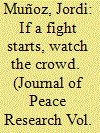

|
|
|
|
|
| Summary/Abstract |
Social movements often face tactic diversification. In otherwise nonviolent movements, some groups or radical flanks may resort to violent actions such as street rioting. This article analyzes the impact that these violent episodes can have on popular support for the movement as a whole. To estimate the causal effect of violence, it exploits an unexpected riot outbreak that occurred during the fieldwork of a face-to-face survey in Barcelona in May 2016, led by a squat group linked to the anti-austerity movement known as the 15-M or indignados that emerged during the financial crisis. By comparing respondents interviewed before and after the riots, it finds that the street violence episode reduced support for the 15-M movement by 12 percentage points on average. However, the magnitude of the effect is highly conditional on the respondents’ predispositions towards the movement. Core supporters, that are expected to share the frame of the movement in justifying violent actions, are the least affected by the violent outbreak. On the other extreme, weak supporters, opposers, and non-aligned citizens reduce their support to a larger extent. Results are robust to different specifications and a wide range of robustness checks. These findings have potentially important implications for movements concerned with broadening their support base.
|
|
|
|
|
|
|
|
|
|
|
|
|
|
|
|
| 6 |
ID:
167285
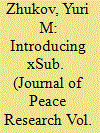

|
|
|
|
|
| Summary/Abstract |
Researchers today have access to an unprecedented amount of geo-referenced, disaggregated data on political conflict. Because these new data sources use disparate event typologies and units of analysis, findings are rarely comparable across studies. As a result, we are unable to answer basic questions like ‘what does conflict A tell us about conflict B?’ This article introduces xSub – a ‘database of databases’ for disaggregated research on political conflict (www.x-sub.org). xSub reduces barriers to comparative subnational research, by empowering researchers to quickly construct custom, analysis-ready datasets. xSub currently features subnational data on conflict in 156 countries, from 21 sources, including large data collections and data from individual scholars. To facilitate comparisons across countries and sources, xSub organizes these data into consistent event categories, actors, spatial units (country, province, district, grid cell, electoral constituency), and time units (year, month, week, and day). This article introduces xSub and illustrates its potential, by investigating the impact of repression on dissent across thousands of subnational datasets.
|
|
|
|
|
|
|
|
|
|
|
|
|
|
|
|
| 7 |
ID:
167278
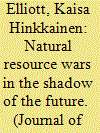

|
|
|
|
|
| Summary/Abstract |
Previous studies on natural resources and civil wars find that the presence of natural resources increases both civil conflict risk and duration. At the same time, belligerents often cooperate over resource extraction, suggesting a temporal variation in the contest over this subnational space. This study argues that parties fight over natural resources primarily when they expect that the conflict is about to end, as the importance of controlling them increases in the post-conflict setting. In contrast, belligerents that anticipate a long war have incentives to avoid fighting near natural resources since excessive violence will hurt the extraction, trade, and subsequent taxation that provide conflict actors with income from the resource. We test our argument using yearly and monthly grid-cell-level data on African civil conflicts for the period 1989–2008 and find support for our expected spatial variation. Using whether negotiations are underway as an indicator about warring parties’ expectations on conflict duration, we find that areas with natural resources in general experience less intense fighting than other areas, but during negotiations these very areas witness most of the violence. We further find that the spatial shift in violence occurs immediately when negotiations are opened. A series of difference-in-difference estimations show a visible shift of violence towards areas rich in natural resources in the first three months after parties have initiated talks. Our findings are relevant for scholarship on understanding and predicting the trajectories of micro-level civil conflict violence, and for policymakers seeking to prevent peace processes being derailed.
|
|
|
|
|
|
|
|
|
|
|
|
|
|
|
|
| 8 |
ID:
167279
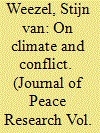

|
|
|
|
|
| Summary/Abstract |
This study exploits a sudden and abrupt decline in precipitation of the long rains season in the Horn of Africa to analyze the possible link between climate change and violent armed conflict. Following the 1998 El Niño there has been an overall reduction in precipitation levels – associated with sea-surface temperature changes in the Indian and Pacific Oceans – resulting in an increase in the number and severity of droughts. Given that the probable cause of this shift is anthropogenic forcing, it provides a unique opportunity to study the effect of climate change on society compared to statistical inference based on weather variation. Focusing on communal conflict in Ethiopia and Kenya between 1999 and 2014, exploiting cross-sectional variation across districts, the regression analysis links the precipitation decline to an additional 1.3 conflict events per district. The main estimates show that there is a negative correlation between precipitation and communal conflict with a probability of 0.90. Changing model specification to consider plausible alternative models and accommodate other identifying assumptions produces broadly similar results. The generaliziability of the link between precipitation decline and conflict breaks down when using out-of-sample cross-validation to test the external validity. A leave-one-out cross-validation exercise shows that accounting for climate contributes relatively little to improving the predictive performance of the model. This suggests that there are other more salient factors underlying communal violence in Ethiopia and Kenya. As such, in this case the link between climate and conflict should not be overstated.
|
|
|
|
|
|
|
|
|
|
|
|
|
|
|
|
| 9 |
ID:
167284
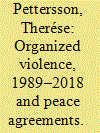

|
|
|
|
|
| Summary/Abstract |
This article reports on trends in organized violence and peace agreements collected by the Uppsala Conflict Data Program (UCDP). The number of fatalities in organized violence decreased for the fourth consecutive year, to reach the lowest level since 2012. In 2018, UCDP recorded almost 76,000 deaths: a decrease of 20% compared to 2017, and 43% compared to the latest peak in 2014. State-based armed conflict drives this downward trend in organized violence, with Syria accounting for much of the change. The number of civilians killed in one-sided violence also dropped in 2018, reaching its lowest level since 2012. In contrast, non-state conflict remained on a high level. The general decline in fatalities from organized violence does not correspond with the trend in the number of active conflicts. In fact, the world has seen a new peak in the number of conflicts after 2014, matched only by the number of conflicts in the early 1990s. In 1991, the peak in the number of armed conflicts corresponded with a similar peak in the number of signed peace agreements. This was followed by a decrease in the number of conflicts in the late 1990s and early 2000s. However, the most recent rise in armed conflicts has not been matched by a similar rise in the number of peace agreements. Two circumstances that characterize the recent rise in conflicts have also been found to make conflicts harder to solve: explicit religious claims and high levels of internationalization.
|
|
|
|
|
|
|
|
|
|
|
|
|
|
|
|
| 10 |
ID:
167283
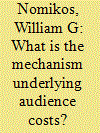

|
|
|
|
|
| Summary/Abstract |
Audience cost theory posits that concern over the nation’s reputation pushes voters to sanction leaders who make empty threats because they tarnish the nation’s honor. We question the empirical support for that theory. We show that survey vignettes in the previous experimental literature conflate audience costs generated by inconsistency and belligerence with approval losses arising from the perception that the leader is incompetent. These ‘incompetence costs’ are due to leaders not achieving audiences’ preferred outcomes. Our article contributes to the literature on audience costs by disentangling inconsistency and belligerence costs from incompetence costs, which we find are the larger component of audience costs. We also make a methodological contribution: we show that experimental designs in previous studies cannot test the different mechanisms; that previous estimates of audience costs are biased because treatments affect respondents’ beliefs about the likely outcome of policy actions; and we suggest a new experimental framework to estimate audience costs. Our results are consistent with arguments that audiences care more about policy outcomes than about leaders’ inconsistency or belligerence during a crisis.
|
|
|
|
|
|
|
|
|
|
|
|
|
|
|
|
|
|
|
|
|